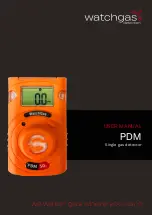
FIRE
R M LD
FIRE
R M LD
Operator’s Manual
27
GAS LASER
Doc No. 16162 Rev A, GAS LASER Operator Manual
© 2021 Teledyne Gas Measurement Instruments Ltd. All rights reserved.
Scanning With The Gas Laser Instrument
(continued)
Meter
· Maintain at least 10 feet from the
meter so the beam width is not
too small.
· Thoroughly scan the ground
around the meter fittings.
· Use the best angle to the meter
that provides a good background
behind the meter.
· If the meter is out in the open, or
the angle is limited such that there
is no background right behind the
meter; scan the meter in a hori-
zontal “Z” pattern maintaining a
constant distance as you sweep
across.
Leak Is Near/On Meter - Determine if Underground or On Meter
· Keep the wind to your back
· Stand 5 to 10 feet from meter
· Start by aiming low on the ground
· Work beam up and around piping
Service Line/Meter - Location Known
· Use the advantage of the beam
by sweeping wider around the
line location.
· Work the beam up the line in an
“S” pattern.
· Scan the meter area.
· Re-scan down the line using
the “S” pattern.
· Move in closer if the range is too
far or ground elevation causes the
beam to not come into contact
with the ground (dark zones).
Service Line/Meter - Location Unknown
· Use an “X” pattern (or similar) to
thoroughly scan the area.
· Target typical vent areas i.e., along
the street or sidewalk edges.
· Target locations where valves may
be placed.
· Scan along the foundation of
the structure.
· Move in closer if the range is too
far or ground elevation causes the
beam to not come into contact
with the ground creating dark
zones (shadow).
Along the Main
· Use a smooth sweeping motion.
· Keep the beam pointed out 15 to
20 feet. This allows for the beam
footprint on the ground to be
large enough to provide good
coverage, and control over the
path of the beam.
· Scan service tap and valve
areas as you approach them.
· Target probable vent locations such
as cracks, vegetation
damage, etc.
NOTICE: Spotter laser is about 1.25”
to the right of the IR laser beam.
NOTICE
WARNING: The visible green Spotter
laser is a Class 2 (II) laser product.
WARNING: Do not stare
into beam or view directly
with optical instruments.
WARNING: Avoid direct
eye exposure to the laser
and do not point in the
direction of others. Visible
and Invisible Lasers are deployed
by this instrument.
WARNING - The Gas Laser is
capable of scanning through
windows to possibly detect methane
gas. However, scanning through
windows is not guaranteed. False
positives and negatives may occur.
AVERTISSEMENT : Le Laser de
repérage vert visible est un produit
laser de classe 2 (II).
AVERTISSEMENT : Ne jamais
fixer le faisceau ni le regarder
directement avec des instruments
optiques.
AVERTISSEMENT : Évitez
l’exposition directe des yeux au
laser et ne le pointez pas vers
d’autres personnes. Des lasers
visibles et invisibles sont déployés
par cet instrument.
AVERTISSEMENT : Le Gas Laser
est capable de balayer les fenêtres
pour éventuellement détecter du
méthane. Cependant, le balayage
des fenêtres n’est pas garanti. Des
faux positifs et des faux négatifs
peuvent être obtenus.
AVERTISSEMENT
WARNING
1.
Gas plume concentration and
size must be greater than the
alarm level of the instrument.
2.
Infrared beam must pass
through the plume.
3.
Background target
(i.e., ground, building, etc.) must
reflect the infrared beam back.
In order to detect gas, three
conditions must be met.
(see visual representation on page 25)
Factors which
influence gas plume size
and concentration:
·
Low-flowing leaks may produce
small to non-measurable plumes.
·
Surface types (i.e., concrete
spread the leak and create
spot leaks through surface cracks
and holes.
·
Weather conditions dissipate
the plume faster (i.e., high winds,
higher temperatures).
·
Weather conditions change the
venting conditions and spread of
gas (i.e., heavy rain and moisture
in the soil,
frost conditions in
winter).
Содержание GAS LASER
Страница 1: ...FIRE R M LD Operator s Manual GAS LASER ...





































